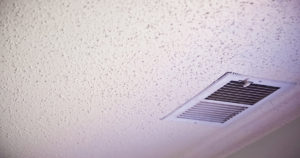
Asbestos becomes a health risk when the fibers become airborne and are inhaled. Breathing in asbestos fibers can lead to an increased risk of lung cancer and mesothelioma. It can also cause the lungs to be scarred with fibrous tissue, a condition called asbestosis. If you are a smoker the risk of these diseases is even greater. It is important to remember that most symptoms from asbestos exposure do not show until 20-30 years after the initial exposure.
If the asbestos product is in good condition, encapsulated and not disturbed, it most likely will not pose a health threat. Asbestos in the home becomes dangerous when it is damaged and the fibers are released into the air. This is most common during home renovations when sawing, scraping, sanding and/or drilling into the asbestos material occurs.
Asbestos is commonly found in residential homes in these products:
*Insulation blankets and tape around pipes, boilers and duct work
*Floor tiles and adhesives
*Cement sheets, mill board and paper used as insulation
*Door gaskets in furnaces, wood stoves and coal stoves
*Soundproofing or decorative materials
*Patching and joint compounds
*Textured paints
*Roofing shingles and siding
*Artificial ashes and embers in gas-fired fireplaces
*Fireproof gloves, stove-top pads, ironing board covers and hair dryers
*Car brake pads and linings, clutch facings and gaskets
*Insulation
Unless the product is labeled, there is no way to know if the product contains asbestos. You should periodically check on the condition of the material. Damage can be caused by tears, abrasions, water, exposure to vibration or air flow or consistent rubbing. If there is any sign of wear or damage, contact a professional to test it. A sample must be sent to a laboratory for examination under a microscope.
If you have had a product tested and it is positive for asbestos you need to take action immediately. First, keep everyone away from the material and avoid any further damage to it. Do not clean, sweep or vacuum as you may be stirring up the asbestos fibers.
Asbestos abatement is a serious issue and must be addressed by a licensed asbestos handler. A professional trained to deal with asbestos should be hired to deal with even the smallest problem.
Make sure the abatement company’s employees are properly trained to deal with asbestos as improper care of the material could put your family at greater risk of exposure. The asbestos abatement company should be in good standing with the Better Business Bureau, the local air pollution control board and the local agency in charge of worker safety. After the contractor has completed the removal and cleanup, it is recommended you hire an independent agency to monitor the air quality in your home to assure the contractor did the job correctly.
Pennsylvania and New Jersey Asbestos Lawyers at the Shein Law Advocate for Victims of Asbestos Exposure
If you suspect you have been exposed to asbestos fibers you may be entitled to compensation. If you would like to speak to an experienced asbestos attorney about your case, contact Shein Law toll free at 877-SHEINLAW (743-4652) or complete our online contact form. We have offices in Philadelphia, Pa and Pennsauken, NJ.
